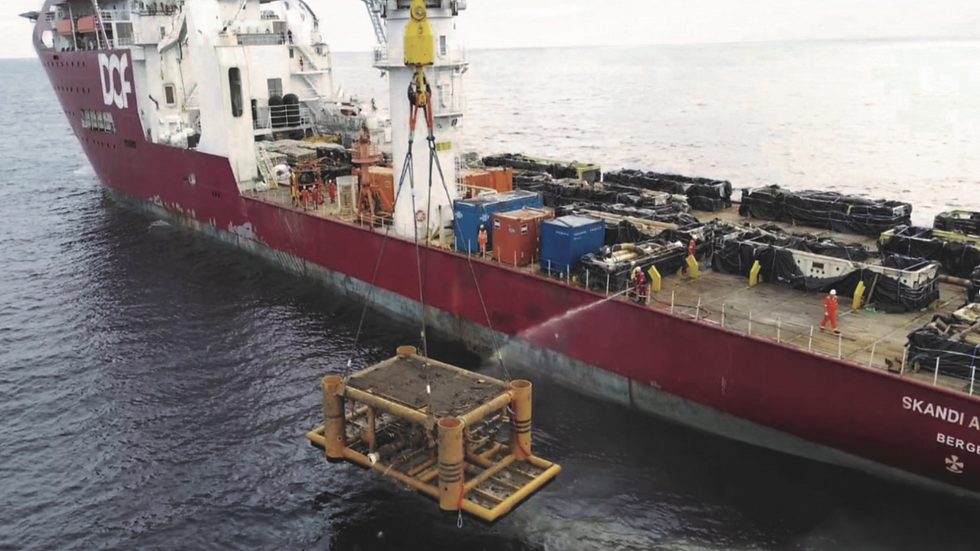Nuclear power barges; Hydrus AUV; £375m UK energy strategy; Autonomous tug
- Sarah Whiteford

- Apr 11, 2022
- 3 min read
It’s Good News Monday!
This Monday we talk about:
Keppel O&M completes autonomous tug project
Samsung and Seaborg Plan Molten Salt Floating Nuclear Power Barges
"All-in-one surveying crew ": Advanced Navigation Launches AUV Hydrus
DOF Subsea: GoM vessel contracts; 99% recycling/repurposing in North Sea decom
UK Government backs Energy Strategy with £375m tech investment

“The Maju 510 tug is owned and operated by Keppel O&M’s joint-venture company Keppel Smit Towage.[Image: Keppel O&M]”. Image from Marine Log.
Keppel Offshore & Marine Ltd has completed its first autonomous vessel, the first in the world to receive the ABS classification society’s Autonomous Notation. Maju 510 is a 65-meter long tug that can be operated from shore with a joystick or navigate autonomously. “It is also the first vessel to receive the Smart (Autonomous) Notation under the Singapore Registry of Ships (SRS) by the Maritime and Port Authority of Singapore (MPA). This certifies the tug’s ability to perform autonomous and remote control navigation in a controlled environment with seafarers on board.” The ship was upgraded by retrofitting advanced detection systems like ABB Ability Marine Pilot Vision and Marine Pilot Control, KMDTech technology, and a digital twin system.

“Power barges using molten salt nuclear reactors will be docked in industrial ports and can be used [to] produce Power-2 fuels (Seaborg)”. Image from The Maritime Executive.
Samsung Heavy Industries is partnering with Seaborg to develop nuclear power plant barges with Seaborg’s Compact Molten Salt Reactors. CMSR barges would be a turnkey solution for power, as well as green hydrogen and ammonia production in ports. The barge would have an expected 24-year lifespan with the first model of an 800MW unit to be developed by next year. Power plants like this are carbon-free and designed to contain any abnormal reactions in case of a runaway reaction, hardening the molten salt around the reactor. “Samsung Heavy Industries separately launched joint research for MSR development with the Korea Atomic Energy Research Institute (KAERI) in June 2021. Among the areas that Samsung is also researching is the use of MSR as a ship propulsion fuel.” Molten salt reactors are being studied by multiple companies as a way to power large vessels like containerships without refueling for years at a time.

“Credit: Advanced Navigation”. Image from Offshore Engineer.
Advanced Navigation has released their small autonomous underwater vehicle (AUV), Hydrus. The goal of Hydrus is to offer a portable all-in-one AUV small enough to carry on a plane while having advanced technology like larger units. It is equipped with a 4k, 60 frame per second camera and bright lighting that combined with AI image processing creates clear images in all kinds of underwater conditions. Advanced Navigation says it’s an entire surveying crew in a small package that can be operated without specific training and retrieved by one person. It has obstacle avoidance, a 3 hour mission duration, and hubless thrusters that won’t get jammed with seaweed or rope.

“Skandi Acergy at work (source: DOF Subsea)”. Image from Riviera.
DOF Subsea has completed engineering, preparation, removal and disposal (EPRD) services in the North Sea with a 99% rate of recycling and repurposing materials. Skandi Acergy and Skandi Skansen handled the work, recovering 135 concrete mattresses, over 12km of rigid pipeline, 15km of flexibles, 1,500 grout bags, and other pieces. 95% of the material was recycled, 4% repurposed, and only 1% landfilled. “On the decommissioning and recovery project, DOF said that 15 concrete mattresses were repurposed into aggregate and used in the roads at the Aberdeen Harbour extension project. Plastic sheaths from the flexible risers and umbilicals were recycled by an approved supplier and all metal was smelted.”

“Hydrogen storage at the European Marine Energy Centre, Orkney.” Image from Energy Voice.
The UK has launched their Energy Security Strategy along with £375 million in funding for offshore wind, hydrogen, nuclear power, and carbon capture and storage (CCUS). The goal is for 95% of UK electricity to be low carbon by 2030, along with the creation of 40,000 clean jobs. The funding is also part of the Net Zero Innovation Portfolio (NZIP), with some of the funding having been previously announced, like the £240m Net Zero Hydrogen Fund to increase blue and green hydrogen production. £100m will go to the Hydrogen Business Model for electrolytic projects and £26m to support adoption of hydrogen. £2.5m will be for a competition to develop advanced modular reactors (AMRs) and £5m for CCUS technology. The investment will help the UK produce more of their energy domestically to improve energy security.
Smile, it’s Good News Monday! :-)



Comments